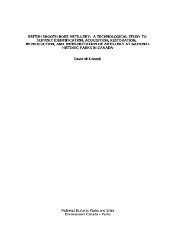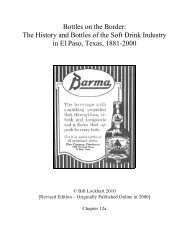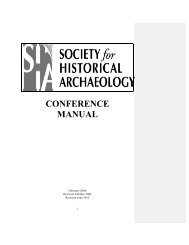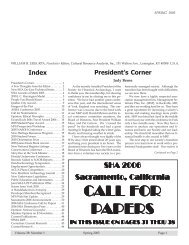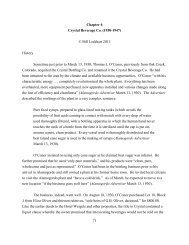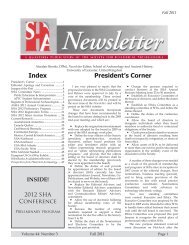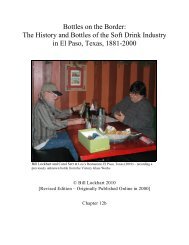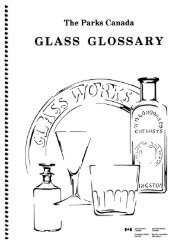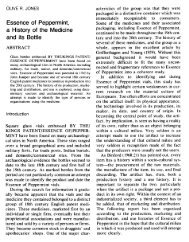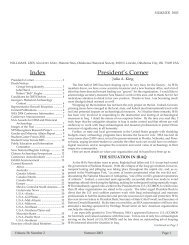- Page 1 and 2:
L'ARTILLERIE LISSE BRITANNIQUE: ÉT
- Page 3 and 4:
TABLE DES MATIERES 9 Sommaire Il Re
- Page 5 and 6:
297 Le granulage 298 Le tamisage -
- Page 7 and 8:
489 TT. 490 UU. 494 VVe 496 WW. 497
- Page 9:
SOMMAIRE En vertu de son mandat d'i
- Page 13 and 14:
AVANT-PROPOS En vertu de son mandat
- Page 15 and 16:
FABRICATION DES PIÈCES D'ARTILLERI
- Page 17 and 18:
Ff\ERICATIO[\l 17 Pour couler une p
- Page 19 and 20:
FABRICATION 19 bois légèrement co
- Page 21 and 22:
FABRICATION 21 du moule à cloche,
- Page 23 and 24:
FABRICATION 23 chaleur. Ils procéd
- Page 25 and 26:
FABRICATION 25 tuant automatiquemen
- Page 27 and 28:
FABRICATIaN 27 On n'a trouvé aucun
- Page 29:
FABRICATIOI'J 29 Il décrivait ensu
- Page 33:
CANONS DE BRONZE 33 Adye, dans ses
- Page 36:
36 CANONS DE BRONZE les diamètres
- Page 39 and 40:
CANONS DE BRONZE 39 La distance ent
- Page 41 and 42:
CANONS DE BRONZE 41 comparer avec l
- Page 43:
Figure 10. Pièce de bronze de 9 li
- Page 46 and 47:
46 CANONS DE BRONZE des notes faisa
- Page 48 and 49:
48 CANONS DE BRONZE 8:3:30 (sic, 20
- Page 50 and 51:
50 CANONS DE BRONZE n'était "pas u
- Page 52 and 53:
52 CANONS DE BRONZE Figure 20. Piè
- Page 56 and 57:
56 CANONS DE BRONZE Figure 24. Piè
- Page 58 and 59:
58 CANONS DE BRONZE On ne sait pas
- Page 60 and 61:
60 CANONS DE FONTE la bouche (CPB)9
- Page 63 and 64:
Les pièces de 42 livres CANONS DE
- Page 65 and 66:
CANONS DE FONTE 65 mais elles demeu
- Page 67 and 68:
CANONS DE FONTE 67 Dans des tables
- Page 69 and 70:
Les pièces de 32 livres de Millar
- Page 71 and 72:
CANONS DE FONTE 71 calibre était l
- Page 73 and 74:
CANONS DE FONTE 73 probable qu'il r
- Page 76:
76 CANONS DE FONTE supérieurs des
- Page 79 and 80:
CANONS DE FONTE 79 principal de que
- Page 81 and 82:
CANONS DE FONTE 81 Dans le compte r
- Page 83 and 84:
) Figure 47. Pièce de fonte de 18
- Page 85 and 86:
CANONS DE FONTE 85 données par Box
- Page 87 and 88:
CANONS DE FONTE 87 (fig. 50); six a
- Page 89 and 90:
Longueur Poids Pi Qtx 9 34 3/4 8 1/
- Page 91 and 92:
Les pièces de 9 livres CANONS DE F
- Page 94 and 95:
94 CANONS DE FONTE temps sur les fl
- Page 96 and 97:
96 Figure '6. Pièce de fonte de 6
- Page 99 and 100:
Les pièces de 4 livres CANONS DE F
- Page 101:
CANONS DE FONTE 101 Quand B1omefie1
- Page 105:
Le canon-obusier de 8 pouces CANONS
- Page 110 and 111:
110 CANONS-OBUSIERS Straith qui acc
- Page 112 and 113:
112 CARONADES de pièces d'artiller
- Page 114 and 115:
114 CARONADES commandes ne tardère
- Page 117 and 118:
CARONADES 117 manifesté aucun int
- Page 119 and 120:
CARONADES 119 des exemples. Il y a
- Page 121 and 122:
LES MORTIERS Descendants des bombar
- Page 123 and 124:
MORTIERS 123 augmentation semble co
- Page 125 and 126:
Figure 77. Mortier royal de bronze
- Page 127 and 128:
MORTIERS 127 possible que Glegg ait
- Page 129 and 130:
MORTIERS 129 longueur 7,8 pouces di
- Page 131 and 132:
MORTIERS 131 renfort, la conception
- Page 134 and 135:
134 MORTIERS Les mortiers de fonte
- Page 136:
136 MORTIERS __ .1' Figure 87. Mort
- Page 142 and 143:
142 MORTIERS Mortier de 13 pouces (
- Page 145 and 146:
LES OBUSIERS L'obusier est une comb
- Page 147:
-- Il,,,,,· [ t'L,,, ...h
- Page 150 and 151:
150 OBUSIERS Figure 102. Obusier de
- Page 152 and 153:
152 ',); illdl li' 11\\ Il, l,::",
- Page 155 and 156:
{; OBUSIERS 155 Figure 108. Obusier
- Page 157 and 158:
Figure Ill. Obusier de bronze de 8
- Page 159 and 160:
OBUSIERS 159 Quand on compare les d
- Page 162 and 163:
162 Figure 115. Obusier de bronze d
- Page 165:
OBUSIERS 165 Un modèle d'obusier d
- Page 171:
Figure 126. Obusier de fonte de 8 p
- Page 174:
174 AFFOTS Les affûts roulants, co
- Page 179 and 180:
AFFÛTS 179 à charnière, à l'ava
- Page 183 and 184:
AFFÛTS 183 Figure 133. Affût de p
- Page 185 and 186:
Figure 135. Affût de place en font
- Page 187 and 188:
AFFÛTS 187 Figure 137. Affûts de
- Page 190:
190 AFFÛTS boulonnées a l'affût
- Page 193:
AFFlJTS 193 Figure 140. Affût en f
- Page 199:
AFFÛTS 199 Les dimensions données
- Page 203 and 204:
AFFÛTS 203 Au milieu des années 1
- Page 205:
Essieu de fer Diamètre de la fusé
- Page 208 and 209:
208 AFFÛTS dessus, par une rose ma
- Page 210 and 211:
210 AFFÛTS tiques spéciales pouva
- Page 214 and 215:
214 AFFÛTS affûts de virer aussi
- Page 220 and 221:
220 AFFÛTS La conception des affû
- Page 225 and 226:
AFFÜTS 225 longueur des flasques,
- Page 231 and 232:
AFFÛTS 231 Au début des années 1
- Page 233 and 234:
AFFÛTS 233 En 1864, Miller précis
- Page 235 and 236:
AFFÛTS 235 Congreve fait une remar
- Page 237 and 238:
AFFÛTS 237 flasques, qui comportai
- Page 240:
240 AFFÛTS l'arrière. Le lissoir
- Page 244:
244 AFFÛTS conception est similair
- Page 247:
AFFÛTS 247 attelage de la meme man
- Page 252:
252 TRAÎNEAUX tenue en place par u
- Page 255 and 256:
TRAÎNEAUX 255 qu'à quatre pouces
- Page 257:
A Traîneau B Flasques C Coffres à
- Page 260 and 261:
260 CHÂSSIS D'AFFÛT Figure 184b.
- Page 262:
Figure 185. Vue de Halifax depuis l
- Page 265 and 266:
CHÂSSIS D'AFFÛT 265 roulettes, d'
- Page 267 and 268:
CHÂSSIS D'AFFÛT 267 Figure 190. D
- Page 269 and 270:
Petit châssis CHÂSSIS D'AFFÛT 26
- Page 271:
CHÂSSIS D'AFFÛT 271 dont le modè
- Page 276 and 277:
276 CHÂSSIS D'AFFÛT ordonnance du
- Page 279 and 280:
LES CHÈVRES La chèvre d'artilleri
- Page 281 and 282:
CHÈVRES 281 Là encore, on ne sait
- Page 283:
CHÈVRES 283 Figure 200. Chèvre d'
- Page 287 and 288:
CHÈVRES 287 années 1820, il Y ava
- Page 290 and 291:
290 CHÈVRES Deux longueurs de cord
- Page 292 and 293:
292 POUDRE Le salpêtre La producti
- Page 294:
294 POUDRE liquide dans des bacs po
- Page 297 and 298:
Le pressage POUDRE 297 Le concept d
- Page 301:
POUDRE 301 se racornir et à s'immi
- Page 306:
306 PROJECTILES Puisqu'il était te
- Page 310 and 311:
310 PROJECTILES Diamètre Diamètre
- Page 312 and 313:
312 PROJECTILES tenant fabriqués a
- Page 314 and 315:
314 PROJECTILES Diamètre du boulet
- Page 317 and 318:
PROJECTILES 317 Un manuel de Strait
- Page 319 and 320:
Type , 10 po a 32 lb 24 lb à 6 lb
- Page 321 and 322:
PROJECTILES 321 marine et les obus
- Page 323 and 324:
PROJECTILES 323 On retrouve ces mê
- Page 325 and 326:
PROJECTILES 325 Il est assez étonn
- Page 329 and 330:
PROJECTILES 329 cuillerée de 4 dra
- Page 332:
332 PROJECTILES Un nouveau mélange
- Page 335 and 336:
PROJECTILES 335 Poids de Diamètre
- Page 337 and 338:
1 ___----J PROJECTILES 337 Figure 2
- Page 339 and 340:
PROJECTILES 339 contre les troupes
- Page 343 and 344:
PROJECTILES 34-3 de fer blanc. Les
- Page 345:
PROJECTILES 345 Peut-être est-ce
- Page 348 and 349:
348 PROJECTILES qui permettait une
- Page 350 and 351:
7 1" , r .,.-'\ Figure 215. Obus de
- Page 353:
LES FUSÉES D'OBUS La fusée permet
- Page 356:
356 FUSÉES rieurs que, dans son en
- Page 359 and 360:
FUSÉES 359 Par contre, la méthode
- Page 361:
La fusée ordinaire de Boxer FUSÉE
- Page 364 and 365:
364 FUSÉES Il existait aussi une f
- Page 366:
366 FUSÉES Les obus de marine de 8
- Page 369 and 370:
FUSÉES 369 de cette action est ret
- Page 371 and 372:
FUSÉES 371 Figure 228. clés pour
- Page 373 and 374:
FUSÉES 373 La composition détonan
- Page 375 and 376:
FUSÉES 375 évasées en leur centr
- Page 378 and 379:
378 FUSÉES Le canal à composition
- Page 381 and 382:
LA MISE À FEU La mise à feu est l
- Page 384 and 385:
384 MISE À FEU 4 fils 6 fils 10 fi
- Page 388 and 389:
388 MISE À FEU tête avait la form
- Page 392 and 393:
392 MISE À FEU L'étoupille à mè
- Page 394 and 395:
394 MISE À FEU les bouts que l'on
- Page 397:
MISE À FEU 397 la lumière, ce qui
- Page 402 and 403:
402 POINT AGE Figure 238. Hausse de
- Page 404 and 405:
404 POINTAGE Figure 239. Hausses de
- Page 406 and 407:
1t0G POINTAGE renfort, et l'autre,
- Page 408 and 409:
408 POINTAGE Vers la fin des annees
- Page 410 and 411:
410 POINTAGE d'environ 12 pieds 1/4
- Page 413 and 414:
APPENDICES Les appendices contienne
- Page 415 and 416:
Charges d'épreuves supplémentaire
- Page 417 and 418:
Appendice B. Utilisation des instru
- Page 420 and 421:
420 APPENDICE C Ces tables d'épreu
- Page 422:
422 APPENDICE 0 Appendice D. Poudre
- Page 425 and 426:
APPENDICE E 425 Appendice E. Dimens
- Page 427 and 428:
Appendice G. Dimensions des canons
- Page 430:
430 APPENDICE J Appendice J. Dimens
- Page 433 and 434:
Appendice M. Dimensions des parties
- Page 436 and 437:
436 APPENDICE N Les largeurs Bc et
- Page 438 and 439:
438 APPENDICE N Table des longueurs
- Page 440 and 441:
440 APPENDICE N Canons Épaisseur d
- Page 442 and 443:
442 APPENDICE N point e comme centr
- Page 444 and 445:
444 APPENDICE N cinquième division
- Page 446 and 447:
446 APPENDICE N Cascabelle, fig. 2
- Page 449 and 450:
Construction des canons selon le sy
- Page 451 and 452:
Construction de la cascabelle d'une
- Page 453 and 454:
Appendice o. Canons-obusiers Longue
- Page 455 and 456:
Appendice P. Notes APPENDICE P 455
- Page 457 and 458:
Appendice R. Table des ferrures uti
- Page 459:
Appendice T. Dimensions des affûts
- Page 462 and 463:
462 APPENDICE V Appendice V. Dimens
- Page 464 and 465:
Appendice X. Dimensions des affûts
- Page 466 and 467:
Appendice Y. Dimensions des affûts
- Page 468 and 469:
468 APPENDICE AA Appendice AA. Dime
- Page 470 and 471:
Appendice BB. Dimensions des ferrur
- Page 472 and 473:
Appendice cc. Dimensions des ferrur
- Page 474 and 475:
Appendice EE. Dimensions des roues
- Page 476 and 477:
Appendice GG. Dimensions des roues
- Page 478 and 479:
Appendice Il. Dimensions des roues,
- Page 480 and 481:
480 APPENDICE KK Appendice KK. Dime
- Page 482 and 483:
482 APPENDICE MM Appendice MM. Dime
- Page 484 and 485:
Appendice 00. Dimensions des essieu
- Page 486 and 487:
Appendice QQ. Dimensions des essieu
- Page 488 and 489:
Appendice 55. Dimensions des moyeux
- Page 490 and 491:
490 APPENDICE UU Appendice UU. Dime
- Page 492 and 493:
492 APPENDICE UU Appendice UU. Dime
- Page 494:
Appendice VV. Dimensions des châss
- Page 497:
Appendice xx. Construction des aff
- Page 500 and 501:
500 APPENDICE YY Appendice YY. Dime
- Page 502 and 503:
502 APPENDICE YY Appendice YY. Dime
- Page 504 and 505:
504 APPENDICE YY Appendice YY. Dime
- Page 506 and 507:
506 APPENDICE ZZ Appendice ZZ. Dime
- Page 508 and 509:
508 APPENDICE AAA Appendice AAA. Di
- Page 511:
Appendice CCC. Dimensions des affû
- Page 515 and 516:
Essieu et corps d'essieu de pièce
- Page 518 and 519:
518 APPENDICE EEE Extérieurement,
- Page 521:
APPENDICE EEE 521 À partir de ce p
- Page 524 and 525:
524 APPENDICE EEE La volée fixe es
- Page 526 and 527:
Appendice FFF. Dimensions des nouve
- Page 529 and 530:
Appendice III. Dimensions des grapp
- Page 531 and 532:
Appendice KKK. Grappes, vers 1860 T
- Page 533:
Appendice MMM. Dimensions des boît
- Page 537:
Appendice QQQ. Boulets sphériques
- Page 543 and 544:
Appendice TTT. Dimensions des fusé
- Page 545 and 546: Appendice VVV. Dimensions des maill
- Page 547 and 548: Appendice XXX. Chargeoirs Type Cont
- Page 549: APPENDICE ZZZ 549 Appendice ZZZ. Di
- Page 552 and 553: 552 APPENDICE CCCC Appendice ccce.
- Page 554 and 555: 554 APPENDICE DDDD Appendice DODO.
- Page 557: Canons de fonte (suite) 12 lb 18 lb
- Page 561 and 562: NOTES La fabrication des pièces d'
- Page 563 and 564: F ABRICATION 563 25 Les mots "bouch
- Page 565 and 566: CANONS DE BRONZE 565 35 RAI, Glegg,
- Page 567 and 568: CANONS DE BRONZE 567 117 Blackmore,
- Page 569 and 570: CANONS DE FONTE 569 21 Miller, op.
- Page 571 and 572: CANONS DE FONTE 571 89 Owen et Port
- Page 574 and 575: 574- CANONS À OBUS 180 RAI, Borgar
- Page 576 and 577: 576 CARONADES 39 Wilford, op. cit.,
- Page 578 and 579: 578 MORTIERS 3 B1ackmore, op. cit.,
- Page 580 and 581: 580 MORTIERS 67 Ibid., p. 127; RMC,
- Page 582 and 583: 582 OBUSIERS livres et 9 quintaux 2
- Page 584 and 585: 584 OBUSIERS 81 Kaestlin, op. cit.,
- Page 586 and 587: 586 AFFUTS ET AV ANT-TRAINS 26 Quar
- Page 588 and 589: 588 AFFUTS ET AVANT-TRAINS 91 Strai
- Page 590 and 591: 590 AFFUTS ET AVANT-TRAINS 14-7 Hug
- Page 593 and 594: CHÂSSIS DE PLATE-FORME 593 2 RAI,
- Page 595: POUDRE 595 2 Le terme flasque sembl
- Page 600: 600 PROJECTILES 21 RAI, Adye (1766)
- Page 603 and 604: PROJECTILES 603 Decline (ci-après
- Page 605 and 606: FUSÉES 605 169 Ibid., p. 391-394-,
- Page 607: MISE À FEU 607 de chaux. 6 Aide-M
- Page 610 and 611: 610 POINTAGE 23 MON, Fitzhugh, op.
- Page 613 and 614: BIBLIOGRAPHIE Sources primaires et
- Page 615 and 616: "Casting Proving Guns &c" Vers 1775
- Page 617 and 618: BIBLIOGRAPHIE 617 commentaires écr
- Page 619 and 620: Trials, Goodwood, 1792 (G3g/10i). T
- Page 621 and 622: BIBLIOGRAPHIE 621 -----. An Element
- Page 623 and 624: BIBLIOGRAPHIE 623 Majendie, Vivian
- Page 625 and 626: BIBLIOGRAPHIE 625 Tousard, Louis de
- Page 627 and 628: BIBLIOGRAPHIE 627 ffoulkes, Charles
- Page 629: Storey, 1968. Rogers, H.C.B. Artill



